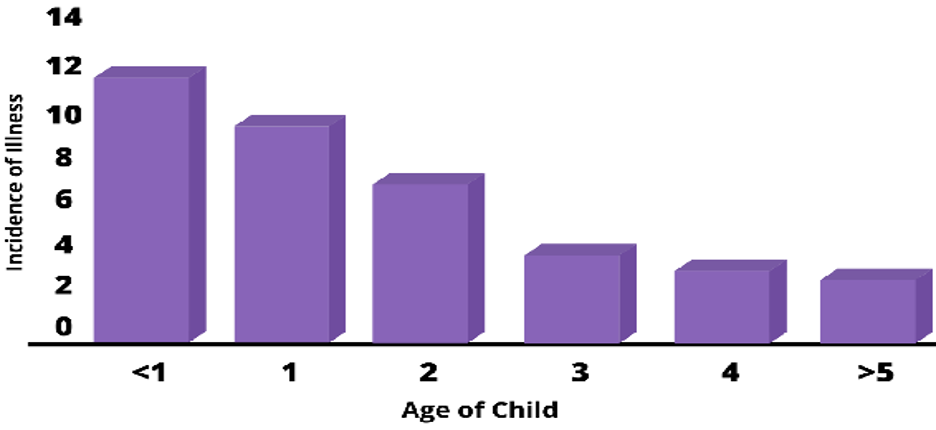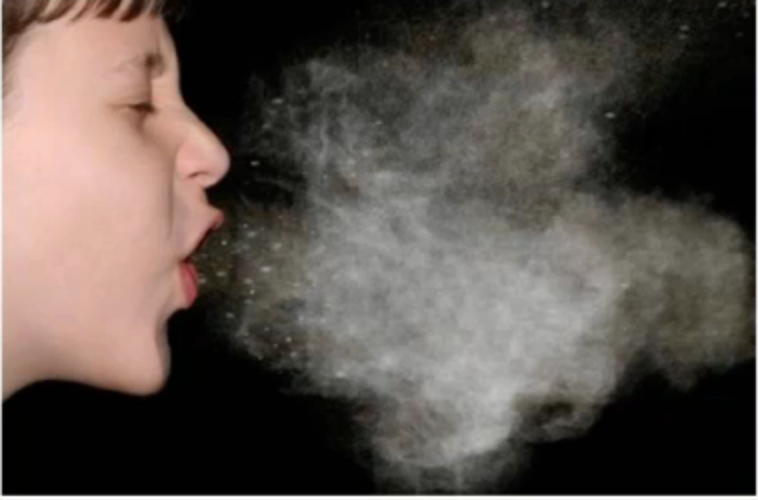Module 3.1 How Illnesses are Transmitted
Learning Objectives
By the end of this module, you should be able to:
- Describe each of the five ways illness is transmitted.
Introduction
Science and experience tell us that infectious disease, especially gastrointestinal disease, which means vomiting and diarrhea, and respiratory disease, including coughs, colds, sore throats, and runny noses, are increased among children who are cared for in out-of-home group settings. In addition, such children may be at increased risk for certain other infections that may be transmitted by insects or by body fluids. It’s also true that children who are cared for in group out-of-home settings are more likely to experience infectious illnesses that are more severe and more prolonged (although 90% of those infections are mild and self-limited, requiring no special treatment).
But there’s good news, too. Once common childhood illnesses such as diphtheria, whooping cough, measles, mumps, and rubella are rare except in communities where immunization rates are low, and polio is unheard of in our country today.
Although younger children are more susceptible to infectious illness because their immune systems are immature, as they grow older, the incidence of infectious disease decreases as their immune systems mature. Furthermore, children who experience more infectious disease at an early age in group out-of-home care have a decreasing incidence of infectious disease as they grow older. In fact, they have less infectious illnesses in kindergarten than children who were taken care of exclusively at home. Illness also decreases with years of attendance in out-of-home early care and education settings.

There are negative consequences of childhood illness, including:
- It’s unpleasant to be sick (for children or the adults that may also become infected).
- Illnesses that are minor in children can be much more serious for adults and pregnant women.
- Some illnesses have severe effects (and can even be life-threatening).
- There are short-term medical costs.
- There may also be additional childcare costs or lost wages for parents/caregivers of children that must be excluded from group care.
- Overuse of antibiotics to get children well contributes to antibiotic resistance among common bacteria.
To prevent illness, we need to understand the different ways illness is spread (Module 3.1), how immunizations protect children (Module 3.2), and what universal precautions early learning and childcare program staff can take to prevent the spread of illness. (Module 3.3)
How Illnesses are Transmitted
Bacteria, viruses, fungi, and parasites that cause illness can be transmitted in five ways, including through:
- The respiratory route
- The fecal-oral route
- The direct contact route
- The bodily fluid route (including blood, urine, vomit, and saliva)
- The vector-borne route
Respiratory Transmission
Most respiratory germs stay in the nose, sinuses, mouth, and throat, or possibly the middle ear. Upper respiratory illnesses (colds) are the most common and the most likely to be transmitted in early learning and childcare programs.
The more common respiratory illnesses include:
- Sinusitis
- Sore throat
- Common cold
- Recurrent middle ear infection
- Strep throat
- Respiratory Syncytial Virus (RSV)
- Pneumonia
- Bronchitis
- COVID-19
Pneumonia and bronchitis are rarely the result of an infection picked up in an early learning and childcare program. We also have immunizations for many respiratory diseases that are rarely transmitted in early learning and childcare programs today, including:
- Mumps
- Measles
- Bacterial meningitis
- Chicken pox
- Diphtheria
- Pertussis
- Pneumonia
- RSV
- Seasonal flu (influenza)
If we could see what comes out of a child’s mouth along with a cough or a sneeze, we might appreciate the respiratory route of infectious disease transmission more.

The germs that are in this contaminated cloud of exhalation can wind up on surfaces and hands and be transmitted to others. Educators and children who can are encouraged to cough into their sleeves. Covering your mouth with your hand only transfers these germs to your hand.
Fecal-Oral Transmission
When organisms that live in our intestines get into our mouths, they can cause illness. Usually, this happens via someone’s hands, usually our own. Fecal-oral routes diseases include:
- Hepatitis A
- Diarrhea
- Hand, foot, and mouth disease
- Pinworms
- Rotavirus
- Norovirus
- Giardia
- Shigella
- Cryptosporidiosis
That is why it is so important that everyone wash hands after using the bathroom, changing diapers, when preparing food, and before eating.
Direct Contact Transmission
Direct contact with another person’s skin (or hair) puts infants and children at risk of illnesses such as:
- Cold sores
- Conjunctivitis
- Pink eye
- Impetigo
- Lice
- Scabies
- Ringworm (a fungus, not a worm).
Bodily Fluid Transmission
Bodily fluids, including saliva, urine, vomit, and blood, can cause illness, such as:
- Dental caries (by saliva)
- Cytomegalovirus or CMV (by urine)
- Hepatitis B (preventable by vaccine)
- Hepatitis C (rare in children)
- HIV (no cases of transmission in an early education setting)
Vector-Borne Transmission
A vector is a living thing that can transmit disease. We know, for example, that ticks can transmit Lyme disease and Rocky Mountain spotted fever. Fleas are known to transmit Bubonic plague and typhus. Mosquitoes can infect people with St. Louis encephalitis (SLE), dengue fever, Zika virus, and West Nile disease. Rats and mice can transmit leptospirosis, trichinosis, hantavirus, and bacterial food poisoning. Raccoons can spread raccoon roundworm.
While these illnesses are relatively uncommon, the risk reminds us of the importance of:
- Utilizing integrated pest management techniques to keep insects and rodents out of buildings.
- Using insect repellant specifically recommended for children during outdoor activities.
- Removing standing water in which mosquitoes can lay their eggs.
- Checking for and removing ticks in centers when children come back in after playing in or near heavily wooded areas.
COVID-19
According to the World Health Organization (WHO), current research has found that the SARS CoV-2 virus that causes COVID-19 can be spread in three ways:
- From an infected person’s mouth or nose in small liquid particles when they cough, sneeze, speak, sing, or breathe to another person in close physical proximity (conversation distance).
- In poorly ventilated and/or crowded indoor spaces because aerosols can remain suspended in the air and travel further than conversation distance.
- Touching the eyes, nose, or mouth after touching an infected surface. (WHO, 2021)
Pause to Reflect 💭
Why is it important to understand how illnesses and diseases are spread?
Why do young children (0 – 3) get illness more than older children (9 – 12)?
Important Things to Remember
- Childhood illness decreases as children age from 0-5 years.
- Illness can be transmitted in five ways: the respiratory route, the fecal-oral route, the direct contact route the bodily-fluid route and the vector-born route.
- There are three different means of transmission of COVID-19.
Resources for Further Exploration
Diseases that may affect First Nations and Inuit communities (Government of Canada)
References
- World Health Organization (2021). Coronavirus disease (COVOD-19): How is it Transmitted? https://www.who.int/emergencies/diseases/novel-coronavirus-2019/question-and-answers-hub/q-a-detail/coronavirus-disease-covid-19-how-is-it-transmitted?gclid=EAIaIQobChMI78XD3du-gQMVoxitBh1PUQkCEAAYASAAEgJCmPD_BwE

